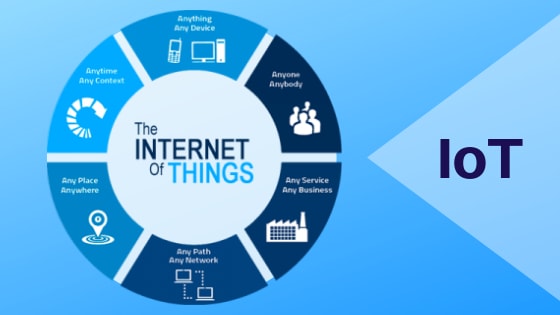Today’s techie world is filled with innovative means making our lives simpler and easier. Whether routine daily tasks or critical business activities – all of them include better-advanced techniques so as to enjoy personalized desired needs. In this internet era, cloud computing technologies have been showing a great impact on business enterprises – Internet of Things (IoT) is the supreme entity currently booming like a rocket in the IT industry. It has got ultimate significance in providing excellent business benefits – cloud providers are competitive in offering the best IoT services to enterprises. Though it may seem a new technical term for some, it is, actually a well-known application that we know and see in our regular life. Here we provide certain basic information on IoT – its applications and working.

IoT – Internet of Things is a system including computing devices, digital and mechanical machines, humans or animals that are interrelated and provided with specific identifiers or sensors. This explanation seems to be too technical and common people cannot catch it.
To view it simpler for anyone, we can say that – IoT is an ecosystem with connected physical objects which can be accessed through the internet. The things involved in IoT include anything from a person or an automobile having sensors. An IP address is assigned to the devices; data can be transferred and collected by a network – there is no need for manual assistance or intervention. Interaction with internal states or the external environment is evident by the embedded technologies within the objects – thereby, certain decisions are taken accordingly.
Internet of Technology is not just limited to traditional devices like laptops, desktops, tablets and smartphones. It has specific uses for even devices like security systems, cars, electronic appliances, thermostats, lights in commercial and household environments, speaker systems, vending machines, alarm clocks, etc.
Smart locks which have sensors detect unique features of individuals and enable security for entry to residential homes and commercial office buildings. Considerable specific technical elements added to the device and recognition through the internet makes only required individuals to enter the office or home. So entrance without identifier or coded element is not possible ensuring higher levels of security.
Different areas including consumer applications, medicine, manufacturing, agriculture, environmental protection, energy, infrastructure management have many IoT applications.
| Area | IoT Applications |
|---|---|
| Consumer applications | Smart home technology, health and fitness apps, smart appliances, wearable tech |
| Medicine | Emergency alert systems, smart devices like hearing aids, smart bed management, remote health monitoring |
| Agriculture | Environmental sensors for farmland information |
| Manufacturing | Smart control of manufacturing systems, plant optimization |
| Energy | Remote control of heating systems, smart grid for balance energy usage |
| Infrastructure management | Monitoring traffic, wind farms, railway track and bridges |
| Environmental protection | Checking pollution levels, soil health, and earth-quake early-warning sensors |
Web-enabled smart devices are involved in IoT – they are embedded with sensors, processors and communication hardware. These sensors receive information from the environment and act accordingly. This information is passed on through an IoT gateway or any other edge device – where the data is analyzed locally or by cloud systems. They can take help from some other related devices for a collaborative performance.
No human intervention is required for their actions, however, one can set up the device and change the instructions for data access and monitoring. Based on the IoT specific applications, the communication protocols, networking and connectivity within the web-enabled devices will change.
Therefore, sensors or devices, connectivity, data processing and user interfaces are the main vital considerations of IoT working.
IoT devices are managed well – special features like device provisioning, registration, authentication, configuration, monitoring and troubleshooting are associated – certain companies like Amazon, Bosch and Microsoft also enable device management software. Standardized device management protocols like Open Mobile Alliance’s Device Management (OMA DM) and Lightweight Machine-to-Machine (OMA LwM2M) are prevalent.
Connectivity protocols of IoT also differ with specified IoT applications – OLAP, DTLS, MQTT and many other communication protocols can be used. Wireless protocols such as Z-Wave, NFC, Bluetooth Low Energy, Zigbee, and IPv6 can also be used for IoT. In addition, cellular, satellite, Ethernet and Wi-Fi communication systems also work with IoT. However, connectivity protocols should be selected based on particular IoT applications.
IoT is considered to provide multiple benefits to the organizations and common man too. Various applications of IoT progress smooth flow of firms. Here are some benefits of IoT.
It encourages machine-to-machine communication and therefore, work processes are better and more efficient with high quality.
Much more knowledge information is collected and analyzed with the help of IoT – proper analysis is done and IoT, therefore, helps in providing valuable information and aid in making better decisions.
New business opportunities can be obtained with the help of IoT – thereby, increased sales and revenue streams are found. Innovations with IoT have the ability to build strong cases, minimize time to market and also increase the return on investment.
Real-time operations of businesses are made efficient with the help of IoT devices – multiple devices can be connected to the internet for accurate and faster analysis and processes along with high-quality deliveries. Information from logistics, supply chain and factory floor collected by IoT devices help in lessening the time to market, and also downtime due to maintenance.
IoT assures perfect means of security considerations for residential, commercial and business purposes. This technology added to sensors, surveillance cameras and other devices can help in monitoring the workplace of organizations and avoid physical threats.
Obviously, effective devices and processes evident with IoT improve and increase productivity, performance and profitability of businesses.
Therefore, with these benefits of IoT, organizations have got successful benefits in all ways – still, there is much scope for IoT; many other emerging and innovative technologies are added to IoT for making it much more better and available to the organizations.